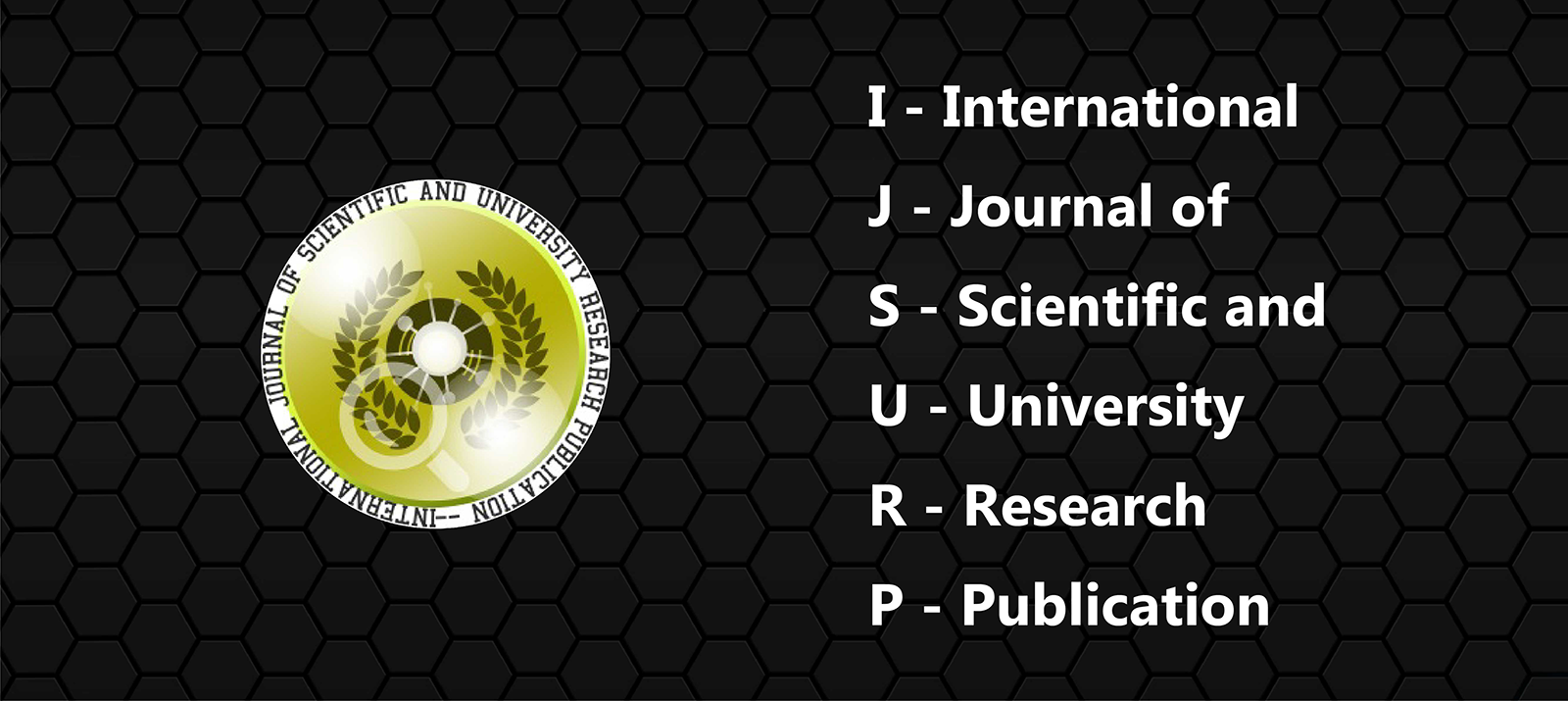
Breeding Biology of Oligonychus Biharensis (Hirst) (Acari: Tetranychidae) – a Pest on Cow Pea
Authore(s) : Sangeetha G Kaimal || Department of ZoologyProvidence Women’s CollegeCalicut – 673 009KeralaIndia.
Volume : (3), Issue : 211, January - 2019

Abstract : Post embryonic development of Oligonychus biharensis (Hirst) was traced on cow pea in the laboratory at 30 +2oC & 70 + 5% RH. Rearing of the life stages of the mite was carried out following leaf flotation technique. The life cycle of the species was found to comprise both sexual and parthenogenetic generations with slight variations in their respective durations. The respective durations of pre-oviposition period, oviposition period and post-oviposition period were found to be 1.5 days, 11.5 + 0.75 days and 0.9 + 0.25 day. Ovipositional rate of the species was observed to be 50.9 + 4.7 eggs and 40.2 + 1.4 eggs for mated and unmated females respectively. Total duration of sexual development and parthenogenetic development was observed to be 6.45 + 0.05 days and 6.0 + 0.07 days respectively. The sex ratio (male: female) was 1-2: 10.
Keywords :Oligonychus ,biharensis, cow pea, oviposition, quiescence, sexual, parthenogenetic development.
Article: Download PDF Journal DOI : 2364/2018
Cite This Article:
Breeding Biology (Hirst) (Acari: Tetranychidae) – a Pest on Cow Pea
Vol.I (3), Issue.I 211
Article No : 10020
Number of Downloads : 133
References :
Aponte O and Mc Murtry J A (1997) Biology, life table and mating behaviour of Oligonychus perseae (Acari: Tetranychidae). Intl. J. Acar., 23(3), 199-207.
Banu K and ChannaBasavanna G P (1972) Plant feeding mites of India I. A pre- liminary account of the biology of the spider mite Eutetranychus orientalis (Klein) (Acari: Tetranychidae).Mysore J. Agri. Sci., 6(3), 253-268.
Barrion A T... More
- Aponte O and Mc Murtry J A (1997) Biology, life table and mating behaviour of Oligonychus perseae (Acari: Tetranychidae). Intl. J. Acar., 23(3), 199-207.
- Banu K and ChannaBasavanna G P (1972) Plant feeding mites of India I. A pre- liminary account of the biology of the spider mite Eutetranychus orientalis (Klein) (Acari: Tetranychidae).Mysore J. Agri. Sci., 6(3), 253-268.
- Barrion A T and Corpuz-Raros L A (1975) Studies on citrus mites (Acarina) : Biology of Eotetranychus cendanai Rimando (Tetranychidae) and population trends in Brevipalpus obovatus Donnadieu (Tenuipalpidae). The Phillipine Entomol., 3(1), 30-45.
- Beavers J B and Hampton R B (1971) Growth, development and mating behaviour of the citrus red mite (Acari: Tetranychidae). Ann. Entomol. Soc. Amer., 64,804-806.20.
- Bonato O and Gutierrez J (1996) Reproductive strategy of two major mite pests (Acari: Tetranychidae) on cow pea in Africa. Ann. Entomol. Soc. Amer., 89(5),676-680.
- Bonato O and Gutierrez J (1999) Effect of mating status on the fecundity and longevity of 4 spider mite species (Acari: Tetranychidae). Expt. Appl. Acarol.,23(8), 623-632.
- Bonato O, Baumgartner J and Gutierrez J (1995a) Comparison of biological and demographic parameters for Mononychellus progresivus and Oligonychus gossypii on cow pea: influence of temperature. Entomol. Experimentalis Appl., 75,119-125.
- Bonato O, Divassa M S and Gutierrez J (1995b) Influence of relative humidity on life-history parameters of Mononychellus progresivus and Oligonychus gos- sypii (Acari: Tetranychidae). Environ. Entomol., 24(4), 841-845.
- Chen W, Fu Y, Zhang F and Peng Z (2005) Effect of different varieties of litchi on the development and reproduction of Oligonychus biharensis (Hirst). Syst. Appl. Acarol. 10, 11-16.
- Congdon B D and Logan J A (1983) Temperature effects on development and fecundity of Oligonychus pratensis (Acari: Tetranychidae). Environ. Entomol., 12,359-362.
- Das G M and Das S C (1967) Effect of temperature and humidity on the de- velopment of tea spider mite, Oligonychus coffeae (Nietner). Bull. Entomol. Res.,57(3), 433-436.
- Ghoshal S, Gupta S K and Mukherjee B (2006) Life cycle of Tetranychus neocal- edonicus Andre on Rhizophora mucronata Lamk, under laboratory condition at controlled temperature. Rec. zool. Surv. India, 106(2), 61-65.
- Gupta S K, Dhooria M S and Sidhu A S (1974) Effect of food and temperature on the development, longevity and fecundity of sugarcane red spider mite Oli- gonychus indicus (Hirst). Acarol., 16(3),436-440.
- Haque M, Wahab A, Naher N and Begum A (2007) Developmental stages of the red spider mite, Oligonychus coffeae Neitner (Acari: Tetranychidae) infesting rose. Univ. J. Zool. Rajshahi Univ., 26, 71-72.
- Ji J, Zhang Y X, Chen X and Lin J Z (2005) Laboratory population life table of Oligonychus biharensis (Hirst) (Acari: Tetranychidae) at different temperatures. Acta. Arachnol. Sinica., 14(1), 37-41.
- Mallik B and Channabasavanna G P (1981) Life history and life tables of Tetra- nychus ludeni and its predator Amblyseius longispinosus (Acari: Tetranychidae; Phytoseiidae). Indian J. Acar., 8, 1-12.
- Manjunatha M and Puttaswamy (1989) Life history of Tetranychus neocaledoni- cus under green house conditions. J. Acar., 11(1 & 2), 35-40.
- Penman D R and Cone W W (1972) Behaviour of male two spotted spider mites in response to quiescent female deutonymphs and to web. Ann. Entomol. Soc. Amer., 65, 1289-1293.
- Puttaswamy and Channabasavanna G P (1981) Influence of weather factors and predators on the populations of the spider mite Tetranychus ludeni (Acari: Tetranychidae). Indian J. Acar., 5, 6979.
- Qureshi A H, Oatman E R and Fleschner C A (1969) Biology of the spider mite,Tetranychus evansi Pritchard and Baker. Ann. Entomol. Soc. Amer., 62, 898-903.
- Reddall A., Sadras, V.O., Wilson, L.J. and Gregg, P.C. (2004) Physiological responses of cotton to two-spotted spider mite damage. Crop Science, 44, 835-846.
- Saha K, Dey P K, Somchoudhury A K and Sarkar P K (1999) Effect of tempera- ture and relative humidity on the rate of development, longevity and fecundity of the red spider mite Oligonychus coffeae. Indian J. Acar., 15(1 & 2), 84-88.
- Sangeetha G K and Ramani N (2007) Biological studies of Tetranychus neocale- donicus Andre (Acari: Tetranychidae) infesting Moringa oleifera Lam., Bull. Pure Appl. Sci., 26A (2), 51-57.
- Sangeetha G K and Ramani N (2008) Effect of temperature and relative humid- ity on oviposition and fecundity of Tetranychus neocaledonicus Andre (Acari: Tetranychidae) – a pest of Moringa oleifera Lam. J. Exp. Zool. India, 11(2), 279-282.
- Sangeetha G K and Ramani N (2011) Biology of Oligonychus biharensis (Hirst) (Acari: Tetranychidae) on cassava. J. Exp. Zool. India, 14(1), 27- 30.
- Sobha T R and Haq M A (1999) Incidence of Tetranychus neocaledonicus (Acari:Tetranychidae) on Dolichos lablab. J. Acarol., 14(1&2), 73-76.
... Less
- Aponte O and Mc Murtry J A (1997) Biology, life table and mating behaviour of Oligonychus perseae (Acari: Tetranychidae). Intl. J. Acar., 23(3), 199-207.
- Banu K and ChannaBasavanna G P (1972) Plant feeding mites of India I. A pre- liminary account of the biology of the spider mite Eutetranychus orientalis (Klein) (Acari: Tetranychidae).Mysore J. Agri. Sci., 6(3), 253-268.
- Barrion A T and Corpuz-Raros L A (1975) Studies on citrus mites (Acarina) : Biology of Eotetranychus cendanai Rimando (Tetranychidae) and population trends in Brevipalpus obovatus Donnadieu (Tenuipalpidae). The Phillipine Entomol., 3(1), 30-45.
- Beavers J B and Hampton R B (1971) Growth, development and mating behaviour of the citrus red mite (Acari: Tetranychidae). Ann. Entomol. Soc. Amer., 64,804-806.20.
- Bonato O and Gutierrez J (1996) Reproductive strategy of two major mite pests (Acari: Tetranychidae) on cow pea in Africa. Ann. Entomol. Soc. Amer., 89(5),676-680.
- Bonato O and Gutierrez J (1999) Effect of mating status on the fecundity and longevity of 4 spider mite species (Acari: Tetranychidae). Expt. Appl. Acarol.,23(8), 623-632.
- Bonato O, Baumgartner J and Gutierrez J (1995a) Comparison of biological and demographic parameters for Mononychellus progresivus and Oligonychus gossypii on cow pea: influence of temperature. Entomol. Experimentalis Appl., 75,119-125.
- Bonato O, Divassa M S and Gutierrez J (1995b) Influence of relative humidity on life-history parameters of Mononychellus progresivus and Oligonychus gos- sypii (Acari: Tetranychidae). Environ. Entomol., 24(4), 841-845.
- Chen W, Fu Y, Zhang F and Peng Z (2005) Effect of different varieties of litchi on the development and reproduction of Oligonychus biharensis (Hirst). Syst. Appl. Acarol. 10, 11-16.
- Congdon B D and Logan J A (1983) Temperature effects on development and fecundity of Oligonychus pratensis (Acari: Tetranychidae). Environ. Entomol., 12,359-362.
- Das G M and Das S C (1967) Effect of temperature and humidity on the de- velopment of tea spider mite, Oligonychus coffeae (Nietner). Bull. Entomol. Res.,57(3), 433-436.
- Ghoshal S, Gupta S K and Mukherjee B (2006) Life cycle of Tetranychus neocal- edonicus Andre on Rhizophora mucronata Lamk, under laboratory condition at controlled temperature. Rec. zool. Surv. India, 106(2), 61-65.
- Gupta S K, Dhooria M S and Sidhu A S (1974) Effect of food and temperature on the development, longevity and fecundity of sugarcane red spider mite Oli- gonychus indicus (Hirst). Acarol., 16(3),436-440.
- Haque M, Wahab A, Naher N and Begum A (2007) Developmental stages of the red spider mite, Oligonychus coffeae Neitner (Acari: Tetranychidae) infesting rose. Univ. J. Zool. Rajshahi Univ., 26, 71-72.
- Ji J, Zhang Y X, Chen X and Lin J Z (2005) Laboratory population life table of Oligonychus biharensis (Hirst) (Acari: Tetranychidae) at different temperatures. Acta. Arachnol. Sinica., 14(1), 37-41.
- Mallik B and Channabasavanna G P (1981) Life history and life tables of Tetra- nychus ludeni and its predator Amblyseius longispinosus (Acari: Tetranychidae; Phytoseiidae). Indian J. Acar., 8, 1-12.
- Manjunatha M and Puttaswamy (1989) Life history of Tetranychus neocaledoni- cus under green house conditions. J. Acar., 11(1 & 2), 35-40.
- Penman D R and Cone W W (1972) Behaviour of male two spotted spider mites in response to quiescent female deutonymphs and to web. Ann. Entomol. Soc. Amer., 65, 1289-1293.
- Puttaswamy and Channabasavanna G P (1981) Influence of weather factors and predators on the populations of the spider mite Tetranychus ludeni (Acari: Tetranychidae). Indian J. Acar., 5, 6979.
- Qureshi A H, Oatman E R and Fleschner C A (1969) Biology of the spider mite,Tetranychus evansi Pritchard and Baker. Ann. Entomol. Soc. Amer., 62, 898-903.
- Reddall A., Sadras, V.O., Wilson, L.J. and Gregg, P.C. (2004) Physiological responses of cotton to two-spotted spider mite damage. Crop Science, 44, 835-846.
- Saha K, Dey P K, Somchoudhury A K and Sarkar P K (1999) Effect of tempera- ture and relative humidity on the rate of development, longevity and fecundity of the red spider mite Oligonychus coffeae. Indian J. Acar., 15(1 & 2), 84-88.
- Sangeetha G K and Ramani N (2007) Biological studies of Tetranychus neocale- donicus Andre (Acari: Tetranychidae) infesting Moringa oleifera Lam., Bull. Pure Appl. Sci., 26A (2), 51-57.
- Sangeetha G K and Ramani N (2008) Effect of temperature and relative humid- ity on oviposition and fecundity of Tetranychus neocaledonicus Andre (Acari: Tetranychidae) – a pest of Moringa oleifera Lam. J. Exp. Zool. India, 11(2), 279-282.
- Sangeetha G K and Ramani N (2011) Biology of Oligonychus biharensis (Hirst) (Acari: Tetranychidae) on cassava. J. Exp. Zool. India, 14(1), 27- 30.
- Sobha T R and Haq M A (1999) Incidence of Tetranychus neocaledonicus (Acari:Tetranychidae) on Dolichos lablab. J. Acarol., 14(1&2), 73-76.






